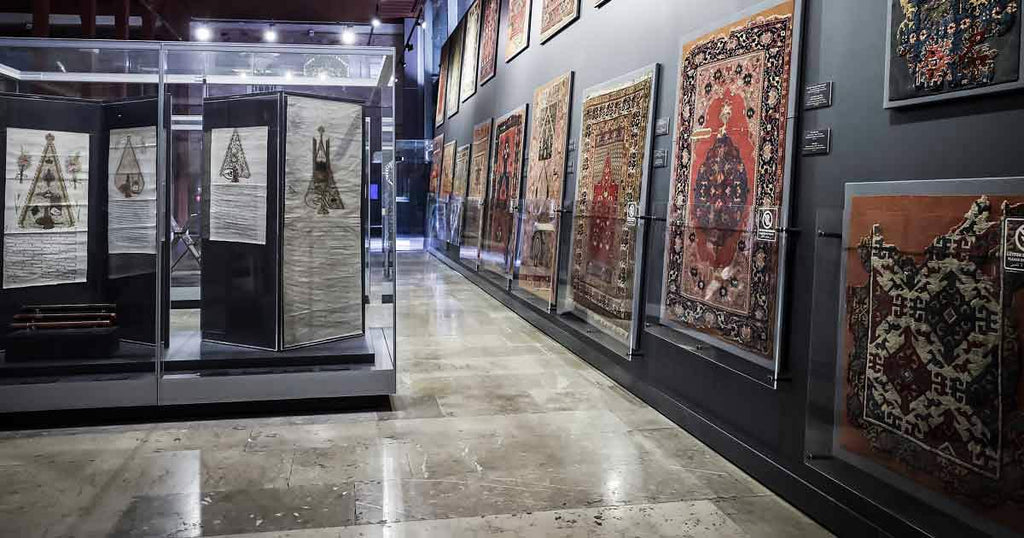Beyond the Floor: Artistic Rugs in Galleries and Museums
Since the dawn of time, handmade rugs have been one of the few things that have passed the test of time with flying colors. Every great story of history, palaces, and even the major rules is related to carpets. Initially designed by Turkish nomads to protect themselves from the cold weather and seek comfort, these handmade marvels earned the recognition of art a long time back. None of the great interiors are complete without rugs. Handmade rugs in any interior are like conversation starters, statement-making pieces that set the base of the interior whilst the other elements in the room act like supporting accents. It might look like these elements are complementing the rug but in reality, the majestic wonder of art complements them.

Apart from all the manuscripts, historical text, weapons, coins, monuments, and other sources of information that tell us about history, handmade rugs speak of history. From their creation to usage, how they were passed down to generations to being recognized as art, handmade rugs come with a history of their own. As the seasons kept changing, the usage and production of rugs kept on evolving. The handmade marvel that once was a mere piece of decoration became a form of expression. As the locals poured their hearts out via the carpet canvas, many historical carpets can be seen embracing story-telling designs, patterns, and information from the olden times. The elite of those times, the ones living in royal palaces, the rulers, and even the colonizers residing in the presidential suites of the East India Company recognized these carpets as art and used these to adorn their homes.
As modernization struck, handmade carpets residing in the palaces became collectibles just like other artifacts. Once again, the carpets earned the titles of heritage and cultural art pieces. While handmade carpets embraced stories of the locals and wars, they featured a variety of motifs and strokes. This made us learn that carpets were not limited to one area. The idea was passed around the world that once originated in the Turkish region. As the researchers, governments, and other restoration institutes realized the importance of these art pieces, they started inspecting each carpet and transporting them to museums.
These carpets are available for the local public if they wish to learn about their history. While one might think that these carpets are of no use behind a glass screen, they pour inspiration into the minds of many designers and rug-making companies. Many rug-makers try to keep history alive by incorporating the designs of the olden times, infusing them with a contemporary touch for the homeowners of today.
- Soon, more and more carpers were being discovered and inspected worldwide, and we kept learning about the world's history and the history of carpet making. The Pazyryk is a 2500-year-old carpet, probably the oldest one in history. This rug is stored in a heritage museum in Russia. The carpet was found in 1949, buried in the grave of a ‘Scythian nobleman in the Bolshoy Ulagan dry valley of the Altai Mountains in Kazakhstan’. This carpet stands as a testament that handmade carpets are timeless marvels and will always remain undefeated by the time. Apart from the carpet’s age, the technicalities of the Pazyryk make it legendary in the category of artifacts. Crafted by the hands of the locals of that time, the carpet has 3600 symmetrical double knots per dm² (232 per inch²), featuring a design portraying a ribbon pattern in the middle, and a border that has deer, and warriors riding on horses, all crafted using wool.
- In the Metropolitan Museum of Art located in the heart of New York resides the Ardabil carpet amongst many other artistic and historical Persian rugs. The rug stands as a masterpiece from the 16th century. A testament to the intricate work of the Persian weavers, the Ardabil carpet inspires rug designers today.
- The Victoria and Albert Museum of London offers a captivating journey to its visitors, a journey in the world of art. Within the halls of this greatest museum of art awaits a significant collection of Persian rugs, each a testament to fine craftsmanship and creativity.
- The Spring Carpet is another work of art that sits in a museum. The Louvre Museum gives home to this rug from the 17th century. Premating Persian nature, the carpet embraces a vibrant design reflecting the artistic vision of the Persian artisans.
Handmade carpets are a lot more than just floor coverings. In some families, these carpets are even passed down as heirlooms. Just like art, ancient handmade carpets also go through auctions and exhibitions. One of the successful exhibitions that drove rugs high into the realm of art was "The Sacred and the Profane: Islamic Carpets from the Collection of Joseph V. McMullan”. The exhibition was held in 1975 at the Metropolitan Museum of Art in New York City. Showcasing the exquisite beauty of the Islamic carpets, the exhibition also highlighted their historical and cultural importance.
At Obeetee Carpets, we have multiple rugs in our collection, especially crafted by the hands of skilled artisans, keeping the art of handmade alive. Each of our carpets features designs inspired by various cultures, traditions, and even the most unnoticeable elements of nature. We use only the best quality of material to craft our products. Durable and comfortable, our pieces aren’t just for practical purposes but can be used as tapestries, and wall backdrops and can even be passed down to generations as heirlooms.
For more information or to experience the magic of handcrafted rugs, you can visit our website https://www.obeetee.in/ or any of our flagship stores located in Delhi, Mumbai, Kolkata, Bangalore, and Jaipur.